Category: Cognitive technologies
Cyber-humans and the future of our bodies
Disclaimer (just in case someone decides to take this too seriously): all characters with medical conditions mentioned in this piece are fictional. If you think you recognize yourself—don’t panic. It’s a coincidence, not a diagnosis. Some technologies may have been slightly dramatized in the name of science and storytelling. Everything here is based on open sources and—pardon us—science fiction… sorry, literature. The only real person in this narrative is a patient named Noland Arbaugh. The rest are composite characters, carefully stitched together from respected scientific papers whose authors we wholeheartedly respect (and definitely do not blame for anything).
When we talk about the future, what comes to mind is a gleaming world of hyper-speed computers, robotic assistants, smart homes, and artificial intelligence. But tech doesn’t stop at our doorstep—it breaks in, slips under the skin, and rewires what it means to be human. It touches our nerves, our muscles, our very minds.
In January 2024, Neuralink successfully implanted its first chip into a paralyzed patient. With this device, individuals who have lost the ability to move or speak can now communicate—by thought alone.
Bionic limbs restore motion. Retinal implants bring back sight. Artificial hearts pump blood with a rhythm that rivals their organic predecessors. What once belonged to the realm of science fiction is now being integrated into real-world medicine. These technologies aren’t just breakthroughs—they’re lifelines. Behind every innovation is a story, a person, a second chance at life.
Version: Cyber-Human.
\[SYSTEM BOOT: Homo Sapiens v2.0]
Date: 2055.04.18 // Location: MegaNet 7 // User: \[REDACTED]
Initializing consciousness wrapper…
Biomass confirmed.
Prosthetic sync initiated: \[Arm: Model Bionic-9.2]—status: LOCKED IN.
Haptic and sensory feedback—stable.
Neural uplink in progress…
CortexLink: ONLINE.
Retinal recalibration sequence engaged. Visual protocol:
………
Calibration in progress. Look up… down… right… left…
CAMERA/EYE unit NyxVision—calibrated /// operational.
Implant card (RFID/NFC)—ready for transactions.
Cardio module: BlackCore heart unit—FUNCTIONAL.
Sensory monitor engaged: vitals under constant observation.
No anomalies detected.
Neurochip interface successfully synchronized with both external and internal augmentations.
Welcome back. You are now online.
Homo Sapiens v2.0—system ready.
Neurochip: The Brain’s Operating System
It’s no bigger than a coin—but it can change everything.
The neurochip is a brain-implanted device that enables direct communication with computers, mind-controlled prosthetics, and even the suppression of epileptic seizures—before the patient feels a thing. This is cutting-edge technology where neuroscience, engineering, and artificial intelligence converge.
How the Neurochip Works
Your brain is home to 86 billion neurons, constantly firing electrical signals to talk to each other. The neurochip is an implant that listens to those signals, decodes them—and in some cases, talks back.
It becomes a translator between the human mind and the outside world: a computer, a robotic limb, a smartphone… or even another brain.
These implants are typically placed in the motor or sensory cortex—regions responsible for movement and perception. A neurochip contains hundreds of ultra-thin electrodes embedded directly into brain tissue, connected to an external processing module that interprets the data in real time.
Medical cases and patients:
Epilepsy
Patient ID: A–X
Age: 28
Procedure: Implantation of NeuroWeave v2.5
Diagnosis: Medically refractory epilepsy

Outcome:
- The chip continuously monitors brain activity in real time
- It autonomously intercepts seizures before they begin
- Seizure frequency reduced by 80%; overall condition stabilized
Doctor’s Note:
Firmware updates are essential. Regular neuro-monitoring and calibration are recommended.
How the Neurochip Helps:
A seizure is like a storm in the brain: neurons fire chaotically, flooding the system with electrical noise. The neurochip watches. It listens. And when the chaos starts to rise, it fights back—sending a targeted electrical pulse to cancel the surge before it erupts.
Parkinson’s Disease
Patient: M–R
Age: 63
Procedure: Deep Brain Stimulation Implant – NeuralCore DBS
Diagnosis: Parkinson’s Disease, Stage II
Reason for Intervention: Debilitating tremors, muscular rigidity, severe drop in quality of life

Outcome:
- Tremors dramatically reduced
- Motor coordination significantly improved
- Anti-tremor medication dosage cut by 40%
Doctor’s Note:
The implant requires regular charging and calibration. Possible side effects include brief spatial disorientation. Risk of implant rejection remains.
How the Neurochip Helps:
Parkinson’s strikes at the command centers of motion—disrupting the brain’s ability to execute smooth, coordinated movements. The result: shaking hands, frozen limbs, a body trapped in slow motion.
Total Paralysis
Patient: Noland Arbaugh
Age: 29
Procedure: Neuralink Neurochip Implant – Elon Musk Initiative
Diagnosis: Full-body paralysis following cervical spinal injury
Reason for Intervention: Complete loss of motor control
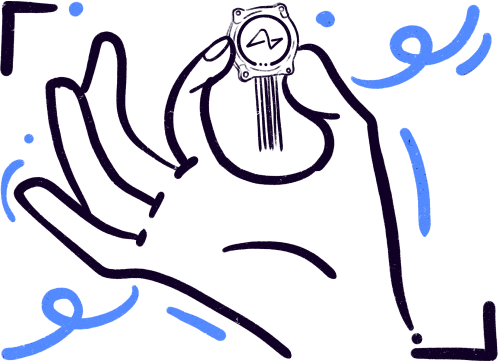
Outcome:
- Patient now operates a computer using only his thoughts
- Has mastered voice assistant control and virtual keyboard navigation via neural interface
- Undergoes daily training: mastering interface protocols, mental exercises, and focus enhancement routines
Doctor’s Note:
Emotional spikes may destabilize the system, causing distorted brain signals and misinterpretation by the neural device. Cognitive therapy and attention training are strongly recommended.
How the Neurochip Helps:
Even in paralysis, the brain doesn’t go silent. It continues to fire motor commands—signals that once flowed into muscle, now stranded in transit. The Neuralink chip intercepts those signals at the source. It listens to the brain’s unspoken intent, decodes it, and relays it directly into action—through a computer, an AI assistant, or even a robotic limb. A person gives an impulse, the system understands and remembers the commands.
Loss of Speech
«Imagine if Stephen Hawking could communicate faster than a speed typist or auctioneer. That is the goal»
Elon Musk
Patient: D
Age: 45
Procedure: NopstR Neurochip Implant
Diagnosis: Post-stroke aphasia
Reason for Intervention: Full loss of speech function, comprehension intact

Outcome:
- Thought-to-text transmission from the brain’s speech center
- Patient achieves 90 words per minute—mind-typing at lightning speed
- Reconnects with loved ones after years of silence
Doctor’s Note:
Custom vocabulary tuning is required. The system is sensitive to cognitive fatigue, which may cause message distortion.
How the Neurochip helps:
Aphasia strikes like a lightning storm—leaving understanding intact, but the bridge to spoken words severed. The NopstR neurochip is implanted near the brain’s speech formulation center. It listens to the neural patterns of intent, decodes them, and translates them into text on a screen. It’s called a speech brain-computer interface. The device analyzes the activity of neurons and determines what words a person is trying to say.
What is expected from this technology in the near future:
Brain-computer speech interfaces are rapidly expanding beyond medical rehabilitation. Soon, brain-computer speech interfaces will decode not just words, but emotion, tone, and context. It is envisioned that people will be able to “speak” in any language—the system will automatically translate thoughts before they even turn into words. Prototype voice avatars are being developed that can convey unique vocal nuances even for those who have never spoken. Looking further ahead, there will be full-fledged neurocommunication: exchanging thoughts directly, without sounds, text, or screens. Conversations that don’t need to be spoken aloud will become possible. Communication will become faster than speech itself. And of course, the ability to silently curse in traffic jams will become a reality—the technology of the future that we deserve.
Mind Over Machine: Neural Command Systems
Patient: L
Age: 29
Procedure: SynBridge v0.9—Experimental Neurochip
Status: Healthy
Mission Objective: Participation in experimental digital control protocols

Outcome:
- Thought-powered control over computers and virtual assistants
- Launching apps without touch
- Stable neural link with digital systems
Doctor’s Note:
Full synchronization still in progress. The brain requires training. Risk of phantom commands under fatigue or distraction.
How the Neural Assistant Works:
This isn’t science fiction—it’s neural precision in real time. With a healthy brain and a chip the size of a grain of rice, you can scroll web pages with a thought, play music with a mood, answer messages with a blink of intent.
No screens. No hands. Just you.
This tech is poised to become the standard for smart homes, neuro-navigation, and the post-touch future.
You don’t click anymore. You command.
Memory Storage: The Flash Drive for the Mind
Patient: Classified
Age: Classified
Procedure: MEMNet Prototype—DARPA USA
Diagnosis: Partial amnesia following trauma
Reason for Intervention: Experimental memory recovery and enhancement

Outcome:
- Accelerated short-term memory for language, data, and events
- Long-term memory recording under testing
Doctor’s Note:
System is unstable under high cognitive stress. Prototype use is restricted to controlled lab environments.
What the Chip Will Do:
Scientists are attempting the unthinkable—recreating memory patterns, storing them externally, and writing them back into the brain. Imagine using up your skills like files on a hard drive.
It’s not perfect—yet. Right now, it works with basic templates. But the goal is audacious: external memory banks for humans. Forget forgetting.
The Union of People and AI
«As computer intelligence gets better, what will be possible when we interface our brains with computers? It might sound scary, but early evidence suggests otherwise: interfacing brains with machines can be helpful in treating traumatic brain injury, repairing spinal cord damage, and countless other applications»
American entrepreneur and venture capitalist Bill Maris
Medical Cases & Patients:
Patient: Classified
Age: Top Secret
Reconstruction: Neuralink Project—integration of a neural implant powered by Artificial Intelligence
Health Status: Classified
Reason for Intervention: Experimental symbiosis between digital intelligence and the human brain
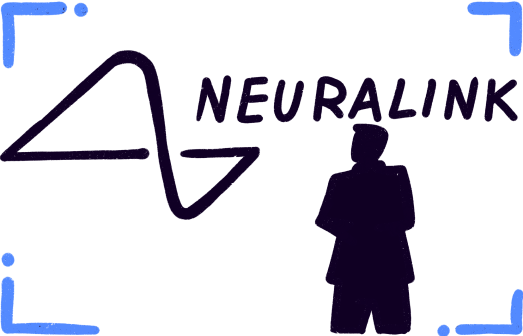
Outcome:
- Testing direct brain-to-digital-model communication
- Real-time cognitive search assistance activated
Doctor’s Note:
This project is still in its infancy. AI must remain isolated from external networks. The risks are high—both for the patient’s safety and mental health.
How it will probably work:
The neural implant links up with AI, turbocharging the brain into a supercharged neural network. Forgot the actor’s name mid-conversation? The AI feeds you the answer instantly. Can’t focus? Boom—“Concentration Mode” kicks in like an internal espresso shot.
Complex problems? Solved in real time. Instant access to knowledge. Thought autocomplete that finishes your mental sentences before you even realize it. Sounds like sci-fi? It’s happening right now, deep in the labs.
This is the first step toward digital consciousness—a cyber-brain in its embryonic form. The era of the “hybrid humans” is quietly knocking on your skull, asking for entry.
Welcome to the future, where the mind is more than a brain—it’s a wired fusion of flesh and code.
BioProsthetics: The Hand That Feels. The Leg That Thinks.
A bionic prosthesis is a smart hand or leg that moves on brain command, bends at the joints, and even senses touch. It connects to nerves, muscles, or a brain interface, reads signals, and executes commands. The game changer? Modern prosthetics deliver feedback: the user can feel when they’re holding or squeezing something and can even sense the temperature of objects.
Medical Cases & Patients:
Patient: K
Age: 26
Reconstruction: Neural interface + NeuralArm v4 prosthetic with tactile feedback
Diagnosis: Right arm amputation
Reason for intervention: Limb function restoration
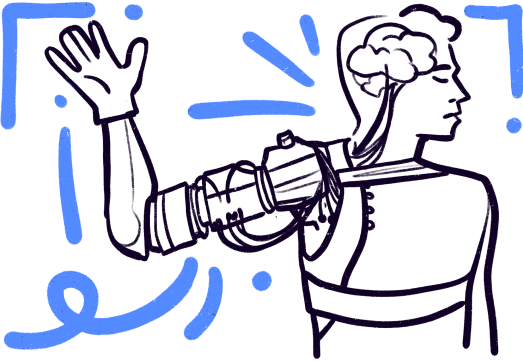
Outcome:
- Full control over hand, fingers, and wrist
- Calibrated tactile feedback (pressure and temperature sensation)
- Patient leads an active lifestyle, back to painting
Doctor’s note:
Monthly synchronization of neural signals with the system is recommended. Sync delays may occur during intense emotional spikes.
How the prosthetic hand helps:
The brain still believes the hand is there—and that’s great news. The prosthetic hooks up to remaining muscles and nerves, intercepts signals, and carries out commands: grip, twist, release, shrug if needed. Built-in finger sensors detect the “grip” and send feedback—via electric pulses, vibration, or touch—back to the skin or nerves. The result? The user actually feels holding the object, how heavy it is, if it’s hot, cold, or just a bit rough. It’s like the brain is chatting with the machine in the good old language of biology—and they totally get each other.
Patient: Z
Age: 41
Reconstruction: NeuroStride leg prosthesis with dynamic adaptation and sensory platform
Diagnosis: Thigh amputation after an accident
Reason for intervention: Restore mobility and return to active life
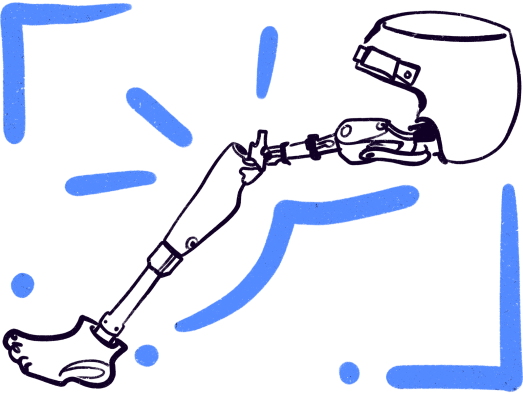
Outcome:
- Confident walking and short-distance running
- Automatic surface adaptation
- Pressure sensation on foot restored, balance regained
Doctor’s note:
Regular calibration of pressure sensors is necessary. Physical rehab recommended to sync with vestibular system.
How the prosthetic leg helps:
Today’s prosthetic leg is no mere machine—it’s almost intuition. Tiny built-in microsensors track every heel strike and adjust movement on the fly, step by step. Signals flow back to the brain, creating sensations of support, pressure, and balance—the body remembers how to move again. The brain? It’s thrilled too—it’s been waiting for a reliable partner. The result: the user truly walks again—almost like before, but supercharged.
Experiments and the Future
Medical Cases & Patients:
Patient: Captain M
Age: 42
Reconstruction: Military bionic leg prosthesis ExoLimb V3.4 integrated with an exoskeleton
Diagnosis: Right leg amputation above the knee after a mine explosion
Reason for intervention: Veteran rehabilitation and system testing for special forces soldiers

Outcome:
- Full control over the bionic leg combined with the exoskeleton
- Endurance boosted by 300%
- Shock resistance and enhanced stabilization in combat conditions
- Patient performed a 3-meter jump without injury
Military doctor’s note:
This system demands serious neuromuscular training—you can’t just strap on the exoskeleton like a bulletproof vest. Under extreme stress, like in battle, signal overload can occur: the brain sends too many commands, and the tech struggles to filter emotions from intentions. That’s why it’s still being tested in real-world conditions—dust, noise, and adrenaline included.
How it works:
The neurochip connects to the brain’s motor cortex and intercepts movement commands: move forward, step aside, jump, hold firm. These signals go straight to the exo-actuators—external “muscles” made of metal and servomotors built into the exoskeleton. The result? Instead of a missing leg, the patient gains a powerful mechanical limb with pinpoint accuracy and built-in stabilization. While some are just relearning how to stand, others are already relearning how to run—stronger, faster, and with more confidence. This isn’t just a prosthesis—it’s the first step toward creating the ultimate soldier of the future.
Seeing and Hearing Again: Vision and Hearing Implants
Eyes and ears—they’re just biological sensors. The eye is a camera. The ear is a microphone. They gather signals and send them to where the real magic happens—the brain. The brain is the boss that decides whether you just saw a cat, a rainbow, or the tax office. And if one of these sensors breaks down—no problem. You can swap it out for a mechanical eye, an electronic ear, whatever you want. The key is getting the signal to the brain. After that, the brain figures out how to interpret it. Because perception isn’t about the senses, it’s the art of the brain.
Medical Cases & Patients:
Artificial Vision
Patient: K
Age: 36
Reconstruction: Implanted neuro-visual eye implant OptiMind Vision Beta
Diagnosis: Complete blindness (optic nerve atrophy)
Reason for intervention: Total vision loss, untreatable by other means
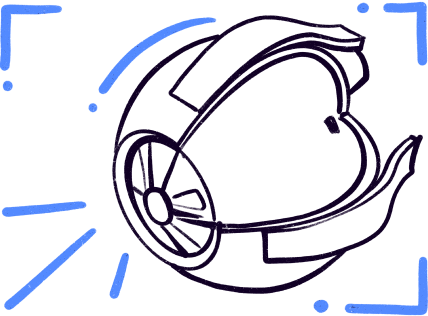
Outcome:
- Patient can distinguish silhouettes, movement, light spots, and large shapes
- Learning to recognize objects by outline, able to navigate indoor spaces
Neurosurgeon’s note:
Vision quality depends on training intensity. Patient is recommended visual rehabilitation: the brain must relearn how to see through the electronic eye. Firmware updates planned to enable color transmission.
How it will work:
The camera captures images, converts them into electrical signals, and sends them via the optic nerve directly to the brain’s visual cortex. This part of the brain is like an old-school projection screen—but way more complex. The brain starts processing these signals as if seeing through real eyes, learning to recognize outlines, colors, and movement. Over time, this machine assistance becomes so natural that the patient no longer notices the difference: for them, it’s not a camera anymore, it’s “normal” vision.
Hearing Implant
Patient: L
Age: 24
Reconstruction: Cochlear implant HearLink v3.2 with neuro-adaptation
Diagnosis: Congenital deafness in both ears
Reason for intervention: Social adaptation, hearing restoration

Outcome:
- Hearing restored up to 65 dB
- Patient can distinguish speech, music, and natural sounds
Otologist’s note:
The implant requires regular tuning and audio training. The brain learns to perceive sounds gradually, which is especially tough for patients without prior hearing experience. To speed things up, music therapy is recommended—it’s like a workout for hearing, expanding the range of perception. The more music, the sharper the hearing.
How it will work:
The implant captures sounds with a microphone, converts them into electrical signals, and sends them to the auditory nerve. Even if the ear doesn’t work, the brain still receives the signals. And here’s the coolest part: over time, the brain learns to interpret these signals as normal sounds. It’s like hooking up an old radio to a new source—at first there’s static, but eventually the station tunes in perfectly and sounds crystal clear.
Experimental Implants:
Secret Protocol “Orion”: Military Neuro-Enhancement of Vision and Hearing
Patient: Code: S-17
Age: Classified
Reconstruction: Integrated neuro-system for visual-audio enhancement—Orion Unit vX.4
Status: Military test subject, early prototype, developed under a defense project

Capabilities:
- Eyes: digital zoom up to 12x, night vision, thermal imaging, glare-flash filtering
- Ears: whisper detection from up to 30 meters, ultrasonic tag detection, combat noise suppression, automatic speech-source focus, built-in translator for 40 languages
- Integration: drone reconnaissance feed streamed directly to the visual cortex
- Alert function: automatic sound amplification in potential threat scenarios
Developer’s comment (anonymous):
This is the next level of sensory reality. S-17 doesn’t just perceive data—he processes it faster than an average human. The experiment is tightly monitored by the Ministry of Defense, with potential adaptation of the tech for rescue and intelligence operations.
Subcutaneous Chips and Sensors
Tiny devices implanted under the skin are the next step toward merging humans with technology. Some act as digital keys, unlocking doors without a single move, while others serve as medical trackers that monitor your health in real time. All of this is compactly hidden beneath the skin—usually in the palm or forearm. Imagine your body becoming an extension of your gadgets, tracking every nuance of life like an app on your smartphone. Could this be the new cyber-reality?
Subcutaneous Payment and Access Chip
Patient: G
Age: 29
Device: BioKey NFC-Implant v1.4
Purpose: Storing digital keys
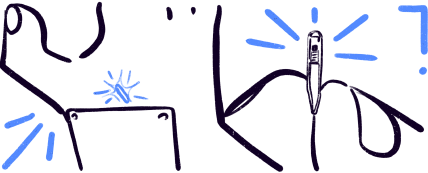
Outcome:
- Patient opens the office and starts a Tesla without keys
- Pays for purchases with a wave of the hand
- Stores and shares business cards and contacts via touch
Engineer’s note:
Convenient, but risks remain—if the chip is compromised, replacing it is harder than swapping a card. We’re currently testing biometric-level chip protection.
Implanted Medical Monitor
Patient: P
Age: 42
Device: NeuroMedTrack BioSensor
Purpose: Real-time monitoring of blood sugar and blood pressure

Outcome:
- Automatic data transmission to the doctor
- Alerts on sudden spikes
Endocrinologist’s note:
These sensors save lives but sometimes give false alarms if the implant shifts or malfunctions. We observed one case of sensor overheating—it caused inflammation, and the chip had to be removed.
How it works:
A miniature sensor is implanted under the skin (usually in the shoulder or abdomen area) to track biochemical parameters like glucose level, blood pressure, body temperature, or electrolyte balance. The device continuously collects data and wirelessly transmits it via Bluetooth or a neuro-interface to the patient’s smartphone and doctor. If readings go beyond safe limits, an alert is sent. The sensor runs on a micro-battery, requiring replacement or recharge every few weeks. Thanks to AI integration, it can predict critical states before physical symptoms even appear.
Experimental Health Monitoring System
Patient: Classified
Age: Classified
Device: LifeCore-7 BioGrid
Purpose: Continuous monitoring of a soldier’s condition in the field

Functions:
- Tracking pulse, cortisol levels, dehydration
- Real-time data transmission to headquarters
- Automatic microdose drug delivery via nanobots when needed
Developer’s note:
The main challenge is signal protection and data security. If this chip gets hacked, the enemy will learn more than we’d like.
How it works:
A network of microsensors is implanted into the soldier’s body, spreading beneath the skin, around arteries, and into muscle tissues like the most patient spies tracking every movement. These sensors monitor the state of the body: heart rate, cortisol levels (this stress hormone doesn’t like to wait), degree of dehydration, and even how fatigued the body is. All this is sent through an encrypted channel to the command center, like a battlefield report.
If readings go beyond normal limits, the system immediately activates built-in nanocapsules containing medicine, which are precisely delivered to the needed tissues.
Thus, you’re no longer just a soldier but a living supercomputer with a bionic upgrade, able to administer medicine right “on the spot” when needed, protecting yourself from overload.
A cyber-soldier ready to endure more than a human—but still remembering that they are human for now.
Artificial Organs: The New Anatomy of Humans
In the medicine of the future, the heart can be metallic, and the liver—grown from the patient’s own cells. Some organs are already being cultivated in laboratories, such as the bladder or trachea, while artificial implants replace vital functions. At the same time, implants can duplicate and even surpass real organs in endurance, reliability, and functionality.
Experimental Patient:
Patient: K
Age: 58
Reconstruction: Implantation of the artificial heart HeartFit-6000
Diagnosis: Irreversible heart damage after a heart attack
Reason for intervention: Complete loss of heart function, life-threatening condition
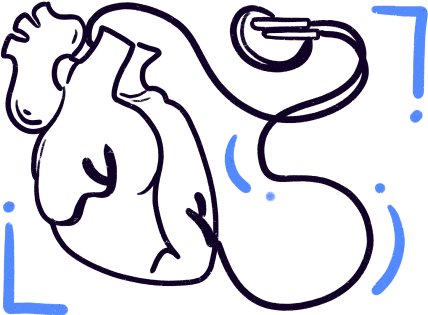
Outome:
- The implant fully replaces the heart: pumps blood without a pulse, creating a constant blood flow
- Operates quietly, steadily, and requires no recharge for 24 hours
- The patient returned to an active life and monitors their condition via an app
Cardiac surgeon’s note:
Growing a heart is not possible yet, but technology already allows replacing it. A heart made of titanium and polymers is more reliable than a living one and cannot be broken by stress. We receive real-time data about the patient’s health and can intervene before anything goes wrong.
How the implant will work:
A normal heart beats and creates pressure waves—a pulse. An artificial heart works differently: it pumps blood continuously, without beats. This is imperceptible to the patient but beneficial for the body—the blood flow is steady, and organ nutrition is stable. All control is automatic, and sensors monitor any deviations.
Reality Upgrade
When technology becomes part of the body, it stops being just tools; it becomes an extension of ourselves. Prosthetics can already feel, chips can transmit thoughts, artificial organs work better than biological ones. We heal what was once considered incurable for centuries. We restore voice, vision, and movement. We rewrite the boundaries of what is possible. But in doing so, we also rewrite what it means to be human.
Will this give rise to new forms of inequality, new ethical dilemmas, new vulnerabilities—from cyber threats to dependence on firmware? Will there be a new temptation to replace what we merely want to improve?
This is not just a technological revolution. This is a rewrite of the species.
And perhaps, people living today will be only the first version of Homo Sapiens.
A navigator determines the current location of a person on Earth. We’re mapping new routes in your consciousness.
Thank you!




